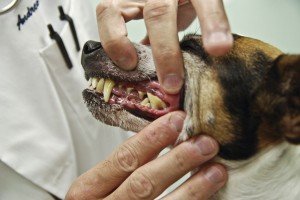5 Facts About Anesthesia and Dentistry

When pet owners hear the word “anesthesia,” many respond in fear for their pet’s life. These FACTS can help you be more comfortable with anesthesia for your pet.
FACT #1:
Non-anesthetic dentistry can cause significant stress and pain. Imagine: Strangers are shining bright lights in your face and inserting sharp tools into your mouth. This is what a pet endures during a non-anesthetic dental procedure. Pets who are anesthetized are able to rest comfortably while the veterinary team performs a thorough exam and cleaning.
FACT #2:
Using anesthesia during dental treatments is safe and convenient. Your veterinarian will tailor the anesthesia used to your pet’s age, health status, and the type of procedure needed. Regardless, most dental treatments are outpatient procedures, so your pet will go home the same day.
FACT #3:
Dental treatments using anesthesia are more effective than non-anesthetic dental treatments. Without anesthesia, a pet dental cleaning will—at best—only clean the visible surface of the tooth. The remaining bacteria, plaque, and, tarter, which is hiding beneath the gum line will not be removed. Using anesthesia, your pet’s veterinary team can conduct a comprehensive cleaning under the gums and leave your pet’s teeth truly clean.
FACT #4:
Dental treatments using anesthesia are more economical than non-anesthetic dental treatments. Because the majority of dental disease occurs under the gumline, pets who undergo non-anesthetic dentistry may go for long periods with untreated pain and infection. This can lead to decreased quality of life for them and increased financial costs for you. Additionally, performing bloodwork prior to anesthesia provides another way for you to assess your pet’s overall health and catch subtle changes before problems occur.
FACT #5:
Anesthesia allows your veterinarian to properly evaluate your pet’s teeth. If only pets would sit still and gently “bite down” on the x-ray film like you do when your dentist radiographs your mouth. Dental radiographs reveal the 60% of a dog or cat’s tooth that is hidden beneath the gum line. When a pet is under anesthesia, these dental radiographs can be obtained, so problems that cannot be seen with the naked eye can be identified
- Behavior (12)
- Caring for your pet (266)
- cat (6)
- Community Events (19)
- dog (7)
- From Our Clients (15)
- Happy Tails (9)
- News (424)
- Press (53)
- Products (2)
- Questions (4)
- Recalls (1)
- Special Offers (5)
- Tips & Advice (231)
- Uncategorized (19)
- Veterinary Services (48)
